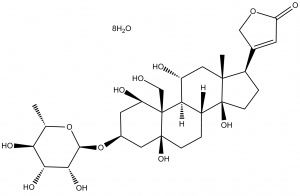Ouabain Octahydrate (Acocantherine)
This product is for research use only, not for human use. We do not sell to patients.

For small sizes, please check our retail website as below: www.invivochem.com
| Size | Price | Stock |
|---|---|---|
| 1g | $200 | To Be Confirmed |
| 10g | $800 | To Be Confirmed |
| 20g | $1200 | To Be Confirmed |
Cat #: V1665 CAS #: 11018-89-6 Purity ≥ 98%
Description: Ouabain (Ouabain Octahydrate; Acocantherine; G-Strophanthin; Strodival; NSC-25485; NSC25485) is a novel, potent and selective Na+/K+, -ATPase inhibitor with the potential to treat heart failure due to myocardial infarction.
Top Publications Citing Invivochem Products
Publications Citing InvivoChem Products
Product Promise

- Physicochemical and Storage Information
- Protocol
- Related Biological Data
- Stock Solution Preparation
- Quality Control Documentation
| Molecular Weight (MW) | 728.77 |
|---|---|
| Molecular Formula | C29H44O12.8H2O |
| CAS No. | 11018-89-6 |
| Storage | -20℃ for 3 years in powder formr |
| -80℃ for 2 years in solvent | |
| Solubility In Vitro | DMSO: 100 mg/mL (137.2 mM)r |
| Water: <1 mg/mLr | |
| Ethanol: 100 mg/mL (137.2 mM) | |
| Synonyms | NSC 25485; Acocantherin; G-Strophanthin; Strodival; NSC-25485; NSC25485 |
| Protocol | In Vitro | Ouabain (100 μM) induces NLRP3 inflammasome activation and IL-1β release in macrophages. Ouabain-induced NLRP3 inflammasome activation is mediated through K+ efflux |
|---|---|---|
| In Vivo | Ouabain (3 mg/kg) significantly decreases cardiac contractile force with an enlarged LVESD when mice are primed with LPS. IL-1β deficiency attenuates ouabain-induced cardiac dysfunction and injury. IL-1β secreted by infiltrated macrophages contributes to ouabain-induced cardiac inflammation. Deficiency of NLRP3 and Casp1 attenuates ouabain-induced cardiac dysfunction and macrophage infiltration[1]. Ouabain (30 µg/kg, i.p.) modulates ABCB1 activity in thymocytes of Wistar rats and i |
These protocols are for reference only. InvivoChem does not
independently validate these methods.
| Solvent volume to be added | Mass (the weight of a compound) | |||
|---|---|---|---|---|
| Mother liquor concentration | 1mg | 5mg | 10mg | 20mg |
| 1mM | 1.3722 mL | 6.8609 mL | 13.7218 mL | 27.4435 mL |
| 5mM | 0.2744 mL | 1.3722 mL | 2.7444 mL | 5.4887 mL |
| 10mM | 0.1372 mL | 0.6861 mL | 1.3722 mL | 2.7444 mL |
| 20mM | 0.0686 mL | 0.3430 mL | 0.6861 mL | 1.3722 mL |
The molarity calculator equation
Mass(g) = Concentration(mol/L) × Volume(L) × Molecular Weight(g/mol)
Mass
=
Concentration
×
Volume
×
Molecular Weight*
The dilution calculator equation
Concentration(start)
×
Volume(start)
=
Concentration(final)
×
Volume(final)
This equation is commonly abbreviated as: C1 V1 = C2 V2
Concentration(start)
C1
×
Volume(start)
V1
=
Concentration(final)
C2
×
Volume(final)
V2
Step One: Enter information below
Dosage mg/kg
Average weight of animals g
Dosing volume per animal µL
Number of animals
Step Two: Enter the in vivo formulation
%DMSO
+
%
+
%Tween 80
+
%ddH2O
Calculation Results:
Working concentration:
mg/ml;
Method for preparing DMSO master liquid:
mg
drug pre-dissolved in
µL
DMSO(Master liquid concentration
mg/mL)
,Please contact us first if the concentration exceeds the DMSO solubility of the batch of drug.
Method for preparing in vivo formulation:
Take
µL
DMSO master liquid, next add
µL
PEG300, mix and clarify, next add
µL
Tween 80,mix and clarify, next add
µL
ddH2O,mix and clarify.
Note:
- (1) Please be sure that the solution is clear before the addition of next solvent. Dissolution methods like vortex, ultrasound or warming and heat may be used to aid dissolving.
- (2) Be sure to add the solvent(s) in order.




































